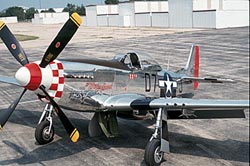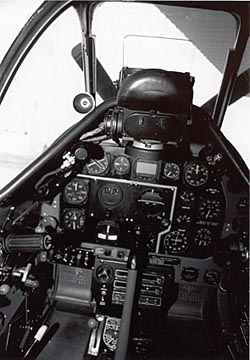
Now located in Springfield, Illinois, U.S. Army Aircraft P-51D-25NA 44-73287, Federal Aviation Administration (FAA) registration number NL951M, is an example of the 8,202 P-51 D Mustang U.S. Army Air Force (USAAF) fighter aircraft manufactured by North American Aviation, Inc., between 1942 and 1945. In its role as a long-range bomber escort in the European Theater of Operations during World War II, the P-51D design exhibited its greatest influence and is credited by many as the airplane that shifted the European airwar in favor of the allied forces. The date of manufacture for this particular aircraft was June 7, 1944. The finished version was delivered to the U.S. Army on March 7, 1945. This P-51D is important in military history through its association with and use by the USAFF, USAF and various U.S. Air National Guard units during and after World War II. P-51Ds were used by these organizations for a variety of missions, including interception of enemy aircraft, long-range bomber escort, armament support for land and sea forces, photographic reconnaissance and flight training. This aircraft exhibits the aerodynamic, power plant armament and other engineering subsystem designs that allowed the P-51D to perform at levels surpassing other single-engine, propeller driven fighter aircraft during World War II. Of the 8,202 P-51Ds manufactured by North American Aviation, Inc., this airplane is one of only 166 remaining in the United States at the end of the 20th century, only 104 of which were operational. The wingspan of 44-73287 is 37.03 feet and has a wing area of 236 square feet. The plane's two-section, semimonocoque fuselage is constructed entirely of aluminum alloy and is 32 feet and 2 5/8 inches in length.
At the end of World War I, air power pioneers in the U.S. and Europe placed a great deal of emphasis on the potential of strategic bombardment based on Italian air war theorist Giulio Douhet's principle of taking long-range bombers and hitting the enemy's war-making potential behind its own lines. It was during the open stages of World War II that the power and influence of modern fighter planes under the control of well-trained pilots became very apparent as the world observed the German Air Force (Luftwaffe) destroy the air forces of Poland, Denmark, Norway, Holland, Belgium and France in late 1939 and early 1940. As the war intensified, so did the German and American fighter design effort. Air-to-air superiority was the dominant concern of both nations, but support roles such as bomber escort, night interception, and strafing/bombing surfaced as the primary secondary functions. The United States put the twin-engine, twin-fuselage Lockheed P-38 Lightning, the Republic P-47 Thunderbolt and the North American Aviation P-51 Mustang in the air to meet these needs. The P-51 Mustangs were initially developed for use by Great Britain against the Germans. The Germans countered the Mustangs with upgraded versions of the Me 109s/110s and the newly introduced Focke Wulf 190. When USAAF strategic bombers deployed to England in 1942, it was thought that the heavily armed B-17s and B-24s could fend off the German fighters during daylight precision bombing. Although the Luftwaffe fighters found it more difficult to close on the USAAF bomber formations, they simply changed their tactics and began attacking the bombers head on. The solution to this dilemma was to produce a fighter to escort the bombers all the way to their target and defend against enemy interdiction.
This need for long-range escorts had not escaped the attention of Commander of the USAAF General Henry H. (Hap) Arnold. In early 1942, Arnold ascertained from previous British air operations that an escort fighter was needed to defend the American bombers if the daylight bombing doctrine was to be successful. The ranges of the fighters, primarily the P-40, P-47 and the P-38, were just not sufficient to accomplish the task. By the fall of 1943, it was apparent the answer to the long-range escort problem was the P-51B/C. When Lieutenant General James H. Doolittle took command of the 8th Air Force in January of 1944, fighter-escort doctrine emphasizing offensive tactics was implemented, allowing the escorts to engage the enemy fighters as they were preparing to attack the bomber streams. Luftwaffe Fighter Chief Adolf Galland stated that, "The day that the USAAF fighters took the offensive was the day that Germany lost the air war." While the P-51 Mustangs also took part in the Pacific War, they were never the dominant airplane. Some were used in the Korean War, but afterwards they were used by Latin American nations, National Guard Units or eventually scraped.

This P-51D entered the European war during the last month of fighting, assigned to the USAAF's 8th Air Force Fighter Command. On July 18th 1945, the aircraft was shipped back to the U.S. and assigned to the 4108th Base Unit at Newark Field, New Jersey, in September. After eventually ending up at Kirtland Air Force Base, New Mexico, it was returned to active duty during the Korean War. Its activated New Mexico unit was redesignated the 188th Fighter/Interceptor squadron, which was transferred to Long Beach, California, in May 1951. After transfers to Yuma Air Force Base and Standiford Field in Louisville, Kentucky, it was flown to the Sacramento Air Material Area, McClellan Air Force Base, California, for reclamation. In June of 1957 it was grounded as excess. On December 11, 1957, it was dropped from the USAF inventory and sold to its first civil owner. The man who saved this P-51D from the scrapper's cutting torch was Willaim Kelbaugh of Chino, California, who eventually sold it to William Sherman Cooper of Merced, California, in 1964, who flew the airplane in the sport of Unlimited Air racing. Through a succession of owners, the airplane eventually was owned by Mike George of Springfield, Illinois, who returned the airplane to its original condition and received the EAA's 1993 Preservation, 1995 Best Mustang and 1995 Silver Wrench Awards at Oshkosh and was named the 1995 Warbird Reserve Grand Champion at the EAA's Sun and Fun Air Show in Lakeland, Florida.
Visit the National Park Service Travel American Aviation to learn more about Aviation related Historic Sites.
Last updated: August 22, 2017
